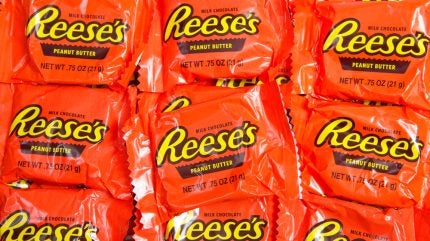
Chocolate giant Hershey is seeking an “exemption” from US tariffs of cocoa imports, the company’s management has confirmed.
Speaking to analysts after Hershey filed its first-quarter results, CFO Steve Voskuil said the Reese’s maker is expecting “incremental tariff expenses” of around $15-20m in its second quarter.

Discover B2B Marketing That Performs
Combine business intelligence and editorial excellence to reach engaged professionals across 36 leading media platforms.
Presenting results last week for the opening three months of 2025, chair and CEO Michele Buck spelt out the steps being taken to combat the effects of Trump’s import levies as Hershey still grapples with elevated cocoa costs.
She did, however, suggest some relief might be on the way from more positive news on cocoa harvests and signs prices might be starting to retreat.
“As a largely domestic food producer, we are relatively less exposed to tariffs than other industries. That said, the current US levy on cocoa is an exposure that we must manage on top of the cocoa market’s unprecedented recent price swings,” Buck said in prepared remarks to accompany the results.
She added: “Cocoa cannot be grown in the United States and thus we are engaging with the US government to seek an exemption.

US Tariffs are shifting - will you react or anticipate?
Don’t let policy changes catch you off guard. Stay proactive with real-time data and expert analysis.
By GlobalData“We are developing robust mitigation plans for other raw material and finished goods exposures with several no-regrets actions already underway.”
Voskuil said tariff expenses will likely increase beyond the second quarter into the back half of the year, if a settlement with the government is not reached, as Hershey clears out inventories.
“The global business environment remains dynamic as negotiations continue. We are hopeful that our largest exposures – cocoa imports and Canadian retaliatory tariffs – will be ameliorated,” Voskuil explained.
The “unmitigated impact” could be as much as $100m a quarter in the final six months of the year, he said.
“If you break that down, two-thirds of it are either cocoa or the Canadian retaliatory tariffs. Those are the two areas where, as you can imagine, we’ve got the most effort focused on influencing government action, using every lever at our disposal to get those tariffs changed, particularly with respect to cocoa, but that’s the impact of unmitigated.”
Hershey’s exposure
Voskuil also outlined what other tariffs exposures Hershey has from raw material imports, besides those of cocoa.
“China for us is not huge, but China is still in that calculation as well. Those by comparison to cocoa and Canada are meaningful, but so much smaller,” he said.
“I’d say we’re looking at exemptions everywhere we can but focusing on the most impactful pieces first. But we do have raw materials that come from other countries as well that also still have some tariffs impact. They’re not off the table for mitigation; it’s just we’re looking first where the biggest impact is.”
Buck said Hershey had acquired the Fulfil Nutrition brand in North America, the timing of which was in April, Voskuil confirmed.
Hershey has operated Fulfil in North America under a joint venture since 2020, Buck clarified in her prepared remarks. The Jolly Rancher sweets maker initially set up the project with Fulfil Nutrition founder Barry Connolly, with Hershey holding an unspecified minority stake at the time.
“Fulfil is now the largest and fastest-growing brand in the protein and energy bar segment in Europe. The brand performs better than most competitors in terms of overall product liking and has tremendous upside, both in the US and internationally,” Buck said.
Last month, the company announced the acquisition of LesserEvil, a US-based organic snack manufacturer. And in November local candy brand Sour Strips was snapped up.
The outlook for cocoa prices
Back on the cocoa front, Buck said prices have retreated over the past few months but added that “cocoa financial markets continue to be disconnected from fundamentals due to a lack of market liquidity, market speculation, and government policy changes”.
She explained the landscape: “There are reasons to believe that this year’s crop marks the beginning of a multi-year growth cycle in cocoa supply. In the meantime, global end users are now responding to persistently high prices in earnest, having waited and watched for some time.
“Based on what we know today, we continue to anticipate inflation next year and robust planning is underway to address persistently high cocoa prices.
“We are readying options to execute, including pricing, price pack architecture, demand shaping and sourcing strategies to mitigate inflation and protect our margins over the long term.”
Buck quantified the impact from the phasing out of petroleum-based food dyes in the US would mostly be felt on Hershey’s sweets portfolio and “some refreshments”.
She explained: “We proactively try to stay ahead of where regulation might be headed, and we’ve been ahead of some of the changes that have been needed like propylparaben banned in California. We were ahead of Red Dye No. 3.
“We’ve had work underway on natural colouring for quite some time. Chocolate should be less impacted. If you look at the ingredient labels, a lot of our products really are pretty simple, natural ingredients.”
Navigate the shifting tariff landscape with real-time data and market-leading analysis.
Request a free demo for GlobalData’s Strategic Intelligence here.




